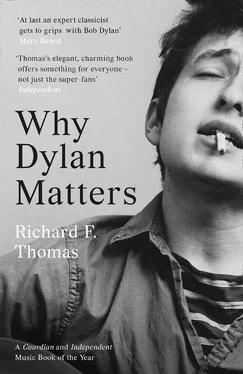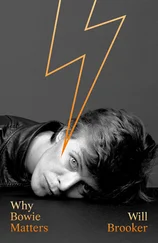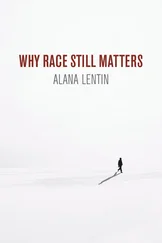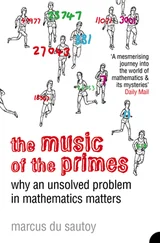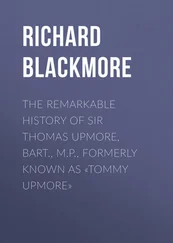This song actually exists in two versions, and in performance with many variations. The first version that Dylan released, on Blood on the Tracks, as quoted above, was actually recorded on December 30, 1974, effectively revising and for many years canceling out an earlier version, which was recorded in September 1974 and eventually released in 1991 on The Bootleg Series Volumes 1–3. In this version, the messenger was a rival, at least in the singer’s imagination: “If you’re makin’ love to her, kiss her for the kid.” The change makes a world of difference, as the element of jealousy complicates things and makes it a different song, as do multiple other changes in yet other versions, including the first known live performance, at Lakeland, Florida, on April 18, 1976, during the second Rolling Thunder Revue, as the Dylans’ marriage was falling apart: “If you’re making love to her, watch it from the rear / You’ll never know when I’ll be back, or liable to appear.” Other parts of the song change in different performances over the years, replaced by brilliant absurdist lines, “Her eyes were blue, her hair was too, her voice was sort of soft,” or a brutal closing to the song in concert in 2002: “If she’s passing back this way, and it couldn’t be too quick / Please don’t mention her name to me, you mention her name it just make me sick.” And the third stanza is gone altogether, absent from official collections of Dylan’s lyrics. But what I heard all those years ago in Ann Arbor was the pure, lyrical version from the 1975 album, and that’s the one that has stayed with me over the years: “Tell her she can look me up if she’s got the time.”
LEAVING AND COMING BACK TO DYLAN
In the fall of 1977, I left Ann Arbor for Cambridge, Massachusetts, to begin teaching in the green pastures of Harvard University, about fifteen years after Dylan met folksinger Eric Von Schmidt in those same pastures. By then my Dylan collection had been topped up. Dylan’s Muse also seemed to have returned in what looked somewhat like a second classic phase, matching the first from a decade earlier. In early 1976, he had released Desire—not quite up to Blood on the Tracks, but fine enough. With Dylan’s next album, Street Legal, appearing in 1978, the winds of change were again beginning to shift in his music. The opening lines of its first song, “Changing of the Guards,” are vivid and allusive: “Sixteen years / Sixteen banners united over the fields,” inviting the listener to look back those sixteen years to the beginning of Dylan’s career, and take stock of how far he’d come and think in the apocalyptic lyrics of the song about where he might be headed: “But Eden is burning, either brace yourself for elimination / Or else your hearts must have the courage for the changing of the guards.” There are some good songs on this album, chiefly for me “Is Your Love in Vain,” but the album as a whole was flawed, as Dylan clearly felt by the best index available: only one song, “Señor,” truly entered the repertoire of Dylan performances, and most he didn’t play after 1978.
For the most devoted Dylan fans who have followed his music through each new stage, his songs and all they evoke become a part of us, with each new album adding another layer. For other fans, he effectively disappeared at various points, starting in 1964 or 1965, quitting their world of folk and protest songs to create a different kind of art. To these fans, Dylan had sold out to a hipster look, and had traded acoustic for electric, with all that connoted for the causes with which they had identified him. But what he gave them in those first two years endured, along with the bittersweet memory of what he had been to them, kept alive by new covers of those particular songs by generations of folksingers who came after. Some disappointed fans stuck around through 1966, hoping that Dylan’s sound, which alternated in performances of that year between solo acoustic and electric with supporting musicians, would return to the former. When it didn’t, these people booed at his concerts, and eventually either came to see what was happening there and found something in it that made sense, or decided to leave for good.
The next crop of Dylan fans to take their leave did so for different reasons, in 1979, when the changing of the guards had come to pass as he started writing and singing Christian songs, often preaching from the stage about hellfire and damnation before launching into his performance. That version of Dylan just didn’t fit in with where they were in their lives or what they believed, or didn’t believe in, or with the Dylan they thought they knew from 1966 or 1975 or some other moment. And so it has continued with Dylan’s constant evolution through the decades, with some fans disembarking and others coming back on board, and newer, younger ones signing up for the first time. It is an essential part of Dylan’s genius that he is constantly evolving as an artist. This is not true of the artists of similar longevity, say Leonard Cohen, Joan Baez, Joni Mitchell, Neil Young, Van Morrison, or Bruce Springsteen. Inevitably that constant evolving creates periods of experimentation and exploration, some less successful than others, but always moving restlessly toward something, and with the music of the last twenty years now having reached, and sustained, a third classic period.
Dylan’s art works in elemental ways, not just through his words and music and voice, but also through his look and appearance. This is also part of his art, from his look of youthful, potent frailty in his early twenties, to his hip and sexualized look on the 1966 tour, through to the powerful maturity of his middle years. His look during the Rolling Thunder Revue tours of 1975–76, which you can see on YouTube and in the 1976 TV movie Hard Rain, is part of the appeal of those performances: 1970s hipster in his mid-thirties, dressed in denim and leather, sometimes sporting a bandana or turban, sometimes with an ornate floral arrangement in his hatband, frequently with white face paint, or with a straggly beard. And into recent years with his elegant, expressive, weather-beaten face, and his scrupulous attention to costume: outfits and hats that at times turn him into a Civil War officer, at times a cowboy, at times the vaudeville performer. In all of these evolutions there is an enigmatic presence that can’t quite be comprehended or described. With Dylan, everything is performance, and all aspects of performance—the words, the music, the voice, the bands, and the look—coming together to create the unique phenomenon that is Bob Dylan.
Конец ознакомительного фрагмента.
Текст предоставлен ООО «ЛитРес».
Прочитайте эту книгу целиком, на ЛитРес.
Безопасно оплатить книгу можно банковской картой Visa, MasterCard, Maestro, со счета мобильного телефона, с платежного терминала, в салоне МТС или Связной, через PayPal, WebMoney, Яндекс.Деньги, QIWI Кошелек, бонусными картами или другим удобным Вам способом.
